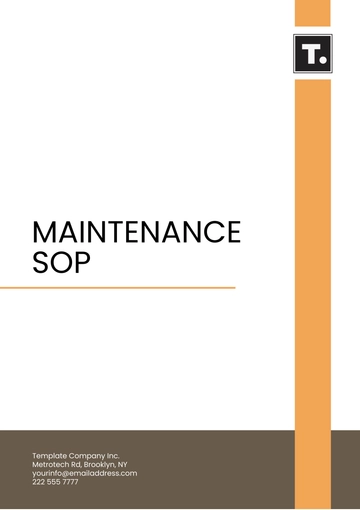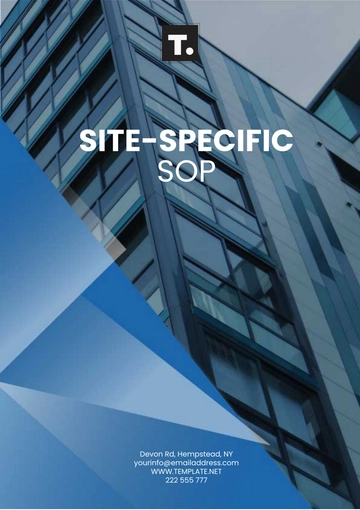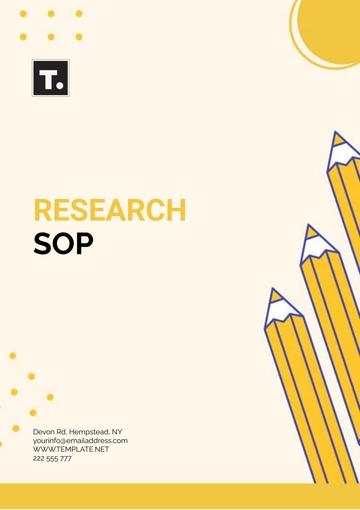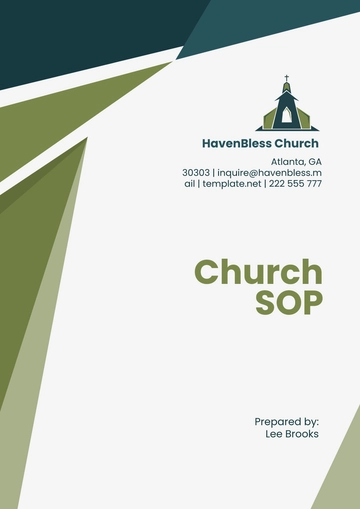Free Agriculture Environmental SOP

I. Introduction
A. Purpose
The purpose of this Standard Operating Procedure (SOP) is to outline the procedures for managing the environmental aspects of operations at [Your Company Name]. This SOP ensures that all activities are conducted in a manner that protects the environment and complies with applicable regulations.
B. Scope
This SOP applies to all employees, contractors, and stakeholders in [Your Company Name]. It covers various environmental management practices, including waste management, water conservation, soil health, pesticide use, and biodiversity conservation. These guidelines help maintain sustainable operations and reduce the environmental footprint.
C. Responsibilities
Management: Management is responsible for providing resources and support necessary for the implementation and maintenance of environmental management practices. They ensure compliance with environmental regulations and policies.
Environmental Officer: The Environmental Officer is responsible for overseeing the implementation of this SOP. This includes conducting audits, training employees, and ensuring all practices comply with environmental regulations.
Employees: All employees are responsible for adhering to the procedures outlined in this SOP. They must participate in training programs and report any environmental concerns to the Environmental Officer.
Contractors: Contractors must comply with the environmental management practices outlined in this SOP. They are required to follow all relevant procedures and report any incidents to their supervisors immediately.
II. Waste Management
A. Waste Segregation
Organic Waste: Organic waste should be separated from other types of waste and placed in designated compost bins. Proper segregation helps in effective composting and reduces landfill usage.
Recyclable Materials: Items such as plastics, glass, and metals should be placed in recycling bins. Proper recycling minimizes environmental impact and promotes sustainable practices.
Hazardous Waste: Hazardous materials must be disposed of in specially marked containers. Correct disposal prevents contamination and ensures safe handling.
General Waste: Non-recyclable and non-hazardous waste should be disposed of in general waste bins. Ensuring correct disposal methods maintains hygiene and environmental safety.
E-Waste: Electronic waste must be collected separately and handled by certified e-waste recyclers. This prevents harmful substances from polluting the environment.
B. Disposal Procedures
The following table provides an overview of the disposal procedures for various types of waste:
No. | Waste Type | Disposal Procedure |
|---|---|---|
1 | Organic Waste | Composting on-site or sent to composting facility |
2 | Recyclable Waste | Sent to recycling facility |
3 | Hazardous Waste | Collected by certified hazardous waste handlers |
4 | General Waste | Disposed of in designated landfills |
5 | E-Waste | Collected by certified e-waste recyclers |
Organic Waste: Composting organic waste on-site reduces the need for chemical fertilizers. This procedure enriches the soil and promotes sustainable farming practices.
Recyclable Waste: Sending recyclable materials to appropriate facilities reduces landfill use and conserves natural resources. Recycling also lowers greenhouse gas emissions.
Hazardous Waste: Proper disposal of hazardous waste prevents environmental contamination and protects human health. Certified handlers ensure safe and compliant disposal.
General Waste: Managing general waste effectively helps maintain cleanliness and reduces environmental pollution. Proper landfill use is crucial for minimizing waste impact.
E-Waste: Handling e-waste correctly prevents the release of toxic substances into the environment. Certified recyclers safely manage and recycle electronic components.
Effective waste management practices ensure that [Your Company Name] minimizes its environmental footprint. These procedures promote sustainability, compliance with regulations, and the health and safety of the community.
III. Water Conservation
A. Water Usage Monitoring
Regular Audits: Conducting regular water usage audits helps identify areas of excessive consumption. This enables targeted interventions to reduce wastage.
Meter Installation: Installing water meters at key points allows for accurate tracking of water usage. Monitoring usage aids in detecting leaks and inefficiencies.
Data Analysis: Analyzing water usage data helps in understanding patterns and trends. Insights from data analysis guide conservation efforts.
Reporting: Regularly reporting water usage to management ensures transparency. Reports facilitate informed decision-making and accountability.
B. Irrigation Practices
Drip Irrigation: Drip irrigation systems deliver water directly to the roots, reducing evaporation. This method is efficient and conserves water.
Scheduled Irrigation: Implementing a fixed irrigation schedule prevents overwatering. Scheduled watering ensures optimal soil moisture levels.
Rainwater Harvesting: Collecting and storing rainwater reduces reliance on external water sources. Harvested rainwater is used for irrigation during dry periods.
Soil Moisture Sensors: Using soil moisture sensors ensures watering only when necessary. Sensors help in avoiding water wastage and over-irrigation.
C. Water Conservation Technologies
The following table highlights key water conservation technologies:
No. | Technology | Description |
|---|---|---|
1 | Drip Irrigation | Efficient water delivery directly to plant roots |
2 | Rainwater Harvesting | Collection and storage of rainwater for later use |
3 | Soil Moisture Sensors | Monitoring soil moisture to optimize irrigation |
4 | Low-Flow Fixtures | Reducing water usage in agricultural operations |
5 | Automated Irrigation | Automated systems to regulate water distribution |
Drip Irrigation: Drip irrigation is a highly efficient method that minimizes water loss. By delivering water directly to the plant roots, it reduces evaporation and runoff.
Rainwater Harvesting: Collecting rainwater provides an alternative water source. This practice is particularly useful during dry seasons, reducing dependency on groundwater.
Soil Moisture Sensors: Soil moisture sensors help in precise irrigation. They ensure that plants receive the right amount of water, preventing both under and over-watering.
Low-Flow Fixtures: Installing low-flow fixtures in operations reduces water consumption. These fixtures help in conserving water without compromising on functionality.
Automated Irrigation: Automated irrigation systems regulate water distribution efficiently. They optimize water usage based on weather conditions and soil moisture levels.
Implementing these water conservation technologies ensures sustainable water usage. These practices not only save water but also enhance the efficiency of agricultural operations at [Your Company Name].
IV. Soil Health Management
A. Soil Testing
Regular Testing: Conduct soil tests regularly to monitor soil health. Regular testing identifies nutrient deficiencies and guides fertilization.
Lab Analysis: Send soil samples to certified labs to ensure accurate results. Lab analysis provides detailed information on soil composition and quality.
Soil pH Monitoring: Monitor soil pH to maintain optimal growth conditions. Correcting pH levels enhances nutrient availability.
Nutrient Mapping: Create nutrient maps based on soil tests to aid in targeted fertilization. Nutrient mapping optimizes resource use and improves crop yield.
Record Keeping: Maintain records of soil tests to help track changes over time. Historical data supports long-term soil health management.
B. Soil Health Practices
Crop Rotation: Rotate crops to maintain soil fertility. Different crops replenish different nutrients, preventing depletion.
Cover Cropping: Plant cover crops to protect soil from erosion. Cover crops also enhance organic matter and soil structure.
Organic Amendments: Add organic matter like compost to improve soil health. Organic amendments increase microbial activity and nutrient availability.
Reduced Tillage: Minimize tillage to preserve soil structure. Reduced tillage prevents soil erosion and enhances moisture retention.
C. Soil Health Indicators
The following table outlines key soil health indicators:
No. | Indicator | Description |
|---|---|---|
1 | Soil pH | Measure of soil acidity or alkalinity |
2 | Organic Matter | Content of organic material in the soil |
3 | Nutrient Levels | Concentration of essential nutrients |
4 | Soil Structure | Arrangement of soil particles |
5 | Microbial Activity | Activity of microorganisms in the soil |
Soil pH: Maintaining optimal soil pH is essential for nutrient uptake. Proper pH levels ensure that plants can access the nutrients they need.
Organic Matter: High organic matter content improves soil fertility. It enhances soil structure, water retention, and microbial activity.
Nutrient Levels: Adequate nutrient levels are crucial for healthy plant growth. Regular soil testing ensures that nutrient deficiencies are addressed promptly.
Soil Structure: Good soil structure promotes root growth and water infiltration. Maintaining soil structure prevents erosion and compaction.
Microbial Activity: Active microbial communities decompose organic matter and cycle nutrients. High microbial activity indicates healthy, fertile soil.
Monitoring these soil health indicators helps maintain productive and sustainable agricultural practices. Soil health management practices enhance crop yields and reduce the need for chemical inputs.
V. Pesticide Use
A. Pesticide Selection
Approved Pesticides: Only use pesticides that are approved by relevant authorities. Approved pesticides ensure compliance with safety standards.
Environmental Impact: Select pesticides with minimal environmental impact. Consider the toxicity and persistence of the pesticide.
Target Specificity: Choose pesticides that target specific pests. Target specificity reduces harm to non-target organisms.
Resistance Management: Rotate pesticides to prevent resistance. Using different modes of action helps in managing pest resistance.
Cost-Effectiveness: Evaluate the cost-effectiveness of pesticides. Choose options that provide the best value while maintaining effectiveness.
B. Application Procedures
Calibration: Calibrate equipment to ensure accurate pesticide application. Proper calibration prevents overuse and reduces environmental contamination.
Protective Equipment: Use appropriate personal protective equipment (PPE) during pesticide application. PPE ensures the safety of the applicator.
Weather Conditions: Avoid pesticide application during adverse weather conditions. Wind and rain can cause pesticide drift and runoff.
Buffer Zones: Establish buffer zones around water bodies and sensitive areas. Buffer zones protect non-target organisms and prevent contamination.
C. Pesticide Storage and Disposal
The following table outlines proper pesticide storage and disposal procedures:
No. | Procedure | Description |
|---|---|---|
1 | Storage Conditions | Store pesticides in a cool, dry, and well-ventilated area |
2 | Labeling | Ensure all containers are properly labeled |
3 | Inventory Management | Keep an accurate inventory of pesticides |
4 | Disposal | Dispose of empty containers and expired pesticides properly |
Storage Conditions: Pesticides should be stored in a cool, dry, and well-ventilated area. Proper storage prevents degradation and reduces the risk of accidents.
Labeling: Ensure all pesticide containers are properly labeled with relevant information. Clear labeling prevents misuse and ensures safety.
Inventory Management: Keep an accurate inventory of pesticides. Regular inventory checks help manage stock levels and prevent overstocking.
Disposal: Dispose of empty containers and expired pesticides properly. Following disposal guidelines prevents environmental contamination and ensures compliance with regulations.
Proper pesticide management practices ensure the safety of workers and the environment. These procedures help in maintaining effective pest control while minimizing negative impacts.
VI. Biodiversity Conservation
A. Habitat Preservation
Protected Areas: Designate specific areas for conservation. Protected areas help preserve native species and ecosystems.
Wildlife Corridors: Establish wildlife corridors to connect habitats. Corridors facilitate the movement of wildlife and promote genetic diversity.
Buffer Zones: Create buffer zones around agricultural fields. Buffer zones protect natural habitats from agricultural activities.
Tree Planting: Plant native trees to enhance biodiversity. Trees provide habitat and food sources for various species.
B. Sustainable Farming Practices
Agroforestry: Integrate trees into agricultural landscapes. Agroforestry enhances biodiversity and provides additional resources.
Cover Crops: Use cover crops to protect soil and provide habitat. Cover crops support beneficial insects and wildlife.
Crop Diversity: Plant a diverse range of crops. Crop diversity reduces pest pressure and enhances ecosystem stability.
Pollinator-Friendly Practices: Implement practices that support pollinators. Protecting pollinators boosts crop yields and biodiversity.
C. Monitoring and Reporting
Species Surveys: Conduct regular surveys to monitor species presence and abundance. Surveys help track biodiversity trends and identify conservation needs.
Habitat Assessments: Assess the condition of habitats regularly. Habitat assessments ensure that conservation areas are maintained effectively.
Reporting: Document and report findings to relevant authorities. Reporting ensures compliance with conservation regulations and informs management decisions.
Adaptive Management: Adjust management practices based on monitoring results. Adaptive management helps in addressing emerging conservation challenges.
VII. Energy Efficiency
A. Energy Audits
Initial Assessment: Conduct an initial energy assessment to identify areas for improvement. Assessments provide a baseline for tracking progress.
Regular Audits: Perform regular energy audits to monitor energy use. Audits help identify inefficiencies and opportunities for savings.
Data Analysis: Analyze energy use data to identify patterns and trends. Data analysis guides targeted interventions for energy conservation.
Reporting: Report audit findings to management for action. Regular reporting ensures transparency and accountability.
B. Energy-Saving Technologies
LED Lighting: Install LED lighting to reduce energy consumption. LED lights are more efficient and have a longer lifespan than traditional bulbs.
Energy-Efficient Equipment: Use energy-efficient equipment in agricultural operations. Efficient equipment reduces energy use and operating costs.
Renewable Energy Sources: Incorporate renewable energy sources such as solar or wind. Renewable energy reduces reliance on fossil fuels.
Automation: Implement automation systems to optimize energy use. Automation helps in monitoring and controlling energy consumption.
C. Energy Management Plan
Goals and Targets: Set specific energy-saving goals and targets. Clear goals and targets help in measuring progress and motivating efforts.
Action Plan: Create an action plan with defined steps. An action plan outlines the measures to be implemented and the timeline for completion.
Monitoring and Review: Regularly monitor and review energy performance. Continuous monitoring helps in identifying areas for improvement and ensures accountability.
VIII. Continuous Improvement
A. Training and Development
Regular Training: Conduct regular training sessions for all employees. Training ensures that everyone is aware of the latest environmental practices and regulations.
Skill Enhancement: Provide opportunities for skill enhancement. Continuous learning helps employees stay updated and improves their performance.
Workshops and Seminars: Organize workshops and seminars on environmental topics. These events provide a platform for knowledge sharing and discussion.
Feedback Mechanism: Implement a feedback mechanism to gather employee inputs. Feedback helps in identifying areas for improvement and enhances engagement.
B. Performance Monitoring
Regular Audits: Conduct regular audits to assess compliance with environmental practices. Audits help in identifying gaps and ensuring continuous improvement.
Reporting: Report performance metrics to management and stakeholders. Regular reporting promotes transparency and accountability.
Corrective Actions: Implement corrective actions based on audit findings. Corrective actions address issues and drive continuous improvement.
C. Innovation and Technology
Precision Agriculture: Use technology to optimize farming practices. Precision agriculture enhances efficiency and reduces environmental impact.
Sustainable Inputs: Adopt sustainable inputs like bio-based fertilizers. Sustainable inputs improve soil health and reduce chemical usage.
Data Analytics: Use data analytics to improve decision-making. Data-driven insights help in optimizing resources and enhancing productivity.
Renewable Energy: Integrate renewable energy solutions in operations. Renewable energy reduces reliance on fossil fuels and promotes sustainability.
IX. Review and Update
A. Review
The management will review this document bi-annually to ensure its relevance and effectiveness. The review process will include:
Annual Review: Conducting an annual comprehensive review of the SOP. This review ensures that all procedures remain up-to-date with current practices and regulations.
Stakeholder Feedback: Gathering feedback from all relevant stakeholders during the review process. Stakeholder feedback provides valuable insights and helps identify areas for improvement.
Audit Findings: Incorporating findings from internal and external audits into the review process. Audit findings highlight compliance gaps and areas needing enhancement.
Performance Metrics: Assessing the effectiveness of the SOP based on key performance metrics. Evaluating performance metrics ensures that the procedures meet organizational goals.
Documentation: Maintaining detailed documentation of all review processes and findings. Thorough documentation ensures transparency and serves as a reference for future reviews.
B. Update
Following the review process, the management will update this document as necessary. The update process will include:
Procedure Revisions: Updating procedures based on review findings and stakeholder feedback. Revisions ensure that the SOP remains aligned with best practices and regulatory requirements.
New Regulations: Incorporating any new regulations or standards into the SOP. Compliance with updated regulations ensures that the organization meets all legal requirements.
Technological Advances: Integrating new technologies and innovations into the procedures. Adopting the latest technologies enhances operational efficiency and environmental sustainability.
Training Programs: Updating training programs to reflect changes in the SOP. Ensuring that employees are trained on updated procedures maintains high standards of environmental management.
Communication: Communicating any updates to all relevant stakeholders. Clear communication ensures that everyone is aware of the changes and understands their roles and responsibilities.
Implementation: Implementing the updated procedures and monitor their effectiveness. Continuous monitoring ensures that the updates achieve the desired improvements.
The management will ensure that the SOP remains a living document, continually evolving to reflect the best practices in agricultural environmental management. Regular reviews and updates will help [Your Company Name] maintain its commitment to sustainability and regulatory compliance.
- 100% Customizable, free editor
- Access 1 Million+ Templates, photo’s & graphics
- Download or share as a template
- Click and replace photos, graphics, text, backgrounds
- Resize, crop, AI write & more
- Access advanced editor
Create detailed standard operating procedures with our customizable Agriculture Environmental SOP Template from Template.net! This template includes editable sections to tailor the content to your edits and the advanced AI Editor Tool ensures efficient and accurate SOP creation, providing a comprehensive guide for your agricultural environmental management! Get your copy!





























